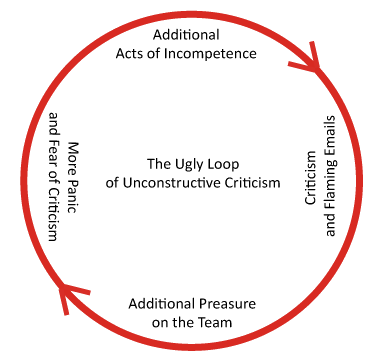The ugly loop of unconstructive criticism
I’m sure you’ve seen this before:

If so, check out the good post it’s from: Not playing the blame game, by Thousandyone.
I’m sure you’ve seen this before:

If so, check out the good post it’s from: Not playing the blame game, by Thousandyone.
Scott: Since you’re one of my favorite innovation peeps, I thought I’d post this here rather than on the source.
While this was a relevant circle in the context of the source story, and something we always need reminding of, I did want to bring up something I’ve run into a lot as of late: an unwillingness to recognize the role that dissonance plays in the innovation process.
I don’t intentionally take an opposite position to get a rise out of people, but when I take a stand and someone disagrees with me, I certainly expect to be able to get down and maybe ‘ugly’ to really work through the differences to potentially uncover some core issue that no one is aware of. I find too many cannot and will not go down such a path.
Some of the best work I ever did was with a guy that we had some of the strongest arguments — coworkers would walk by and say, “Are you guys married or something?” It was just our way of working through both sides of the possibilities.
While there are likely more productive ways of engaging in such depth…you have to wonder. Clearly as humans we often take the path of least resistance and only truly learn when obstacles of great proportion are put in front of us and we have to struggle through them.
Rotkapchen: Point taken. I’m a fan of Hirshberg’s notion of creative abrasion which is close to what you’re talking about – his book has a whole chapter about how he intentionally paired people who disagreed or had different working styles, in the belief there is a positive chemistry that comes from pairing things in conflict.
The rub is that some conflicts are pointless and some are fruitful. Most people don’t notice the difference. I suspect you and your friend enjoyed those arguments – as heated as they were, they were based on mutual respect of some kind. Creating a team environment capable of simultaneous respect and disagreement is very difficult to do, much less teach. I think few people have ever been on teams like this and without experiencing it first hand odds of creating it on your own team are slim.
Watch the making of videos for Pixar’s Incredibles – it’s a good example of intense, high rate of conflict, but high respect/trust environment.
Rotkapchen,
My take on this is simple:
You start by flocking together (http://www.thousandtyone.com/blog/BirdsFlockingTogetherAndWhyConstraintsAreTheBuildingBlocksOfSuccessfulTeams.aspx)
Once you’ve figured out the flocking together part get to like and respect each other genuinely (http://www.thousandtyone.com/blog/TheSecretSauceOfSuccessfulSoftwareDevelopmentTeamsDoYouReallyLikeThemOrAreTheyJustColleagues.aspx).
Once you genuinely like and respect each other you can express your opinions openly (http://www.thousandtyone.com/blog/OpinionatedProgrammersAreBetterThanAFlockOfSheep.aspx) and don’t be afraid to argue (http://www.goodproductmanager.com/2007/08/06/do-not-be-afraid-to-argue/).
The trick is that both sides appreciate each other and have strong opinions that are weekly held (http://bobsutton.typepad.com/my_weblog/2006/07/strong_opinions.html).
As long as that happens, arguments aren’t personal, it is all good. It is when ego and unconstructive criticism comes in that things become ugly.
> Creating a team environment capable of simultaneous respect and disagreement is very difficult to do, much less teach. I think few people have ever been on teams like this and without experiencing it firsthand odds of creating it on your own team are slim.
This is true. To add to it, every programmer who has indeed experienced it first-hand should make an effort to recreate similar environments in his team and spread an open environment where the best ideas flourish.
—
rajiv
(www.thousandtyone.com)
I kind of like criticism.
It can actually be much more helpful than praise. Praise feels good and then that’s it. Criticism eats at you. In fact, the more it eats the more potentially useful it is, because the sting in criticism comes from the kernel of truth hidden inside.
If you get past the sting and look at the kernel of truth full in the face, you have a chance of fixing/improving whatever it is you’re working on. What a gift!
The trick, of course, is knowing how to recognize potentially useful kernel-of-truth criticism from pointless idiotic criticism that says much more about the criticizer than it does about you or your work.
The good news is that this is a learned skill.
Either way, my method of dealing with criticism is to thank the criticizer. The kernel-of-truth ones deserve thanks. The rest will just be confused, which makes the thanking worth it.